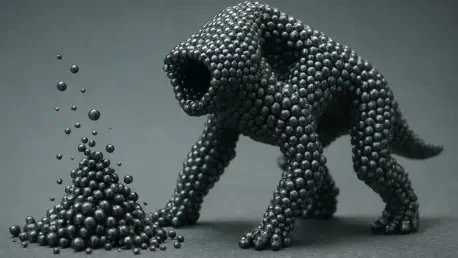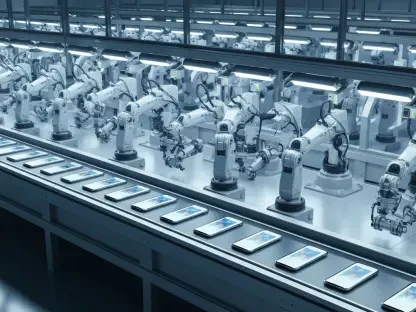Imagine a future where robots adapt to their surroundings with the same ease as living organisms, shifting shapes instantly to tackle complex challenges, a vision that has taken a monumental step forward with a pioneering development in soft robotics from researchers at the Max Planck Institute for Intelligent Systems (MPI-IS) in Germany, in collaboration with Koç University in Turkey. Their creation, detailed in a recent Nature publication, draws inspiration from the nested design of traditional Russian dolls, offering a robot that can transform its form dynamically under a constant magnetic field. This breakthrough isn’t just a technical marvel; it represents a leap toward systems that mirror nature’s adaptability, opening doors to transformative applications across various fields. The ingenuity behind this project, led by Prof. Dr. Metin Sitti, lies in a design that allows real-time shape changes, setting a new benchmark for flexibility and precision in robotic technology.
Technological Breakthrough
Revolutionizing Magnetization in Robotics
The foundation of this robotic innovation rests on a groundbreaking approach to magnetization, known as real-time, in-situ reprogramming. At its core, the system allows the robot to alter its magnetic profile dynamically by adjusting the relative positions of nested tubes packed with magnetic units. Unlike older magnetic robots constrained by fixed profiles that limited their deformations, this method enables a single unit to achieve a wide array of shapes—think of transitioning from a straight rod to a coiled helix—without modifying the external magnetic field. This capability marks a significant departure from past designs, where any shape change required cumbersome adjustments to the surrounding field. The simplicity of using non-magnetic actuation, such as sliding the tubes, to trigger these transformations adds to the elegance of the solution, making it both efficient and adaptable for real-time needs in dynamic environments.
This advancement addresses a long-standing hurdle in soft robotics: the inability to achieve complex deformations under consistent conditions. By enabling the robot to switch between multiple configurations seamlessly, the technology offers unprecedented control over movement and form. For instance, a robot could bend in one direction and then reverse it entirely, all while the external magnetic influence remains unchanged. Such flexibility is critical for applications requiring precision, where even minor misalignments can lead to failure. The research team’s focus on dynamic magnetization not only enhances the robot’s functionality but also paves the way for broader innovations in how magnetic fields are harnessed for robotic control. This shift could inspire future designs that push beyond current limitations, redefining what robots are capable of achieving in constrained or unpredictable settings.
Pushing Boundaries of Control
Beyond the basic mechanics of magnetization reprogramming, the technology introduces a level of control that was previously unattainable in magnetic robotics. The ability to fine-tune the robot’s magnetic profile on the fly means that it can respond to environmental changes almost instantaneously. This responsiveness is achieved through the precise manipulation of the nested magnetic units, which can be aligned or offset to create specific deformation patterns. Such precision opens up possibilities for tasks that demand intricate movements, like navigating tight spaces or performing delicate operations. The implications of this control extend to creating robots that can operate autonomously, adjusting their behavior based on real-time feedback without external intervention.
Moreover, this refined control mechanism sets a new standard for safety and efficiency in robotic systems. Traditional robots with static magnetization often risked unintended interactions or inefficiencies due to their inability to adapt mid-task. In contrast, this new design minimizes such risks by allowing the robot to recalibrate its form as needed, ensuring optimal performance at every step. The potential to integrate this technology with advanced sensors or AI could further enhance its capabilities, enabling predictive shape changes based on environmental data. As research progresses, this level of control could become a cornerstone for next-generation robots, particularly in fields where adaptability is not just beneficial but essential for success.
Design Inspiration and Scalability
Nested Tubes: A Matryoshka Marvel
Drawing from the timeless concept of Russian nesting dolls, the robot’s design features a series of stacked tubes, each embedded with magnetic units that can be programmed and adjusted dynamically. This nested structure isn’t merely aesthetic; it serves as the backbone for the robot’s shape-changing prowess. By sliding the tubes relative to one another, the overall magnetic profile shifts, facilitating a range of deformations under a steady external field. This approach contrasts sharply with earlier robotic designs that were locked into predetermined shapes due to static magnetization. The elegance of this structure lies in its simplicity and effectiveness, allowing for complex transformations without the need for intricate external systems, thus reducing both cost and complexity in potential applications.
The nested tube configuration also offers remarkable scalability, a feature that sets it apart in the realm of soft robotics. The design can be extended from one-dimensional forms to two- and three-dimensional frameworks, broadening its applicability across diverse scenarios. This scalability means that the same foundational concept could be adapted for miniature robots navigating microscopic environments or larger systems handling industrial tasks. Such versatility is crucial for addressing varied challenges, from delicate medical procedures to robust environmental monitoring. The research team’s emphasis on this adaptable structure highlights a forward-thinking approach, ensuring that the technology can evolve alongside emerging needs and technological advancements in the field.
Adapting to Diverse Environments
The structural ingenuity of the nested tube design shines brightest in its ability to adapt to a wide array of environments. Whether operating in confined spaces or open terrains, the robot’s capacity to modify its form in real time ensures it can tackle obstacles that would stymie traditional designs. For example, in tight or irregular spaces, the ability to morph into a more suitable shape—perhaps elongating or curling—allows the robot to maneuver with ease, avoiding damage to itself or its surroundings. This adaptability is not just a technical feat but a practical necessity for real-world deployment, where conditions are rarely predictable or uniform.
Additionally, the design’s scalability enhances its environmental adaptability by allowing customization based on specific demands. A smaller, more compact version of the robot could be tailored for intricate tasks, while a larger iteration might handle heavy-duty operations. This flexibility ensures that the technology isn’t confined to a niche but can span multiple sectors, from healthcare to manufacturing. The potential to refine the design further—perhaps by integrating materials that enhance durability or responsiveness—could amplify its effectiveness in challenging conditions. As exploration into these possibilities continues, the nested tube concept stands as a blueprint for creating robots that thrive in the most demanding of circumstances.
Practical Applications and Potential
Transforming Medicine and Beyond
One of the most promising arenas for this shape-shifting robot lies in the field of medicine, particularly in minimally invasive procedures. Consider the challenges of vascular interventions, where navigating the intricate, curved pathways of blood vessels often results in friction and potential tissue damage. A catheter equipped with this technology could dynamically adjust its shape to align with the vessel’s contours, significantly reducing contact and associated risks. This capability could transform outcomes for patients, especially those with fragile systems who might otherwise avoid such treatments due to safety concerns. The prospect of safer, more effective medical interventions underscores the profound impact this innovation could have on healthcare delivery.
Beyond the medical sphere, the robot’s versatility suggests applications in diverse fields such as industrial navigation and environmental monitoring. In complex industrial settings, the ability to morph shapes could enable robots to access hard-to-reach areas for maintenance or inspection without disrupting operations. Similarly, in fluid manipulation tasks, arrays of these robots could be reprogrammed to mimic cilia, controlling liquid flow with precision. These possibilities highlight the technology’s broad utility, extending its relevance to challenges beyond human health. As researchers delve deeper into practical implementations, the range of sectors benefiting from this adaptability is likely to expand, addressing pressing needs with innovative solutions.
Expanding Horizons of Utility
The potential applications of this robotic technology stretch even further when considering its capacity to operate under unified control systems. In scenarios requiring multiple robotic units—such as coordinated medical instruments or environmental sensors—the ability to manage diverse shapes under a single magnetic field offers unparalleled efficiency. This unified approach reduces the complexity of control systems, making it feasible to deploy fleets of robots for tasks like mapping underwater terrains or performing synchronized surgical maneuvers. Such coordination could streamline operations that currently require multiple, disparate tools, cutting down on time and resources while enhancing precision.
Moreover, the robot’s adaptability could play a pivotal role in emerging fields like microfluidics, where precise control over tiny volumes of liquid is essential. By adjusting their forms to manipulate fluid pathways, these robots could revolutionize processes in biotechnology and chemical engineering. The scalability of the design also means that it can be tailored to specific industry needs, whether for large-scale production or micro-level experimentation. As exploration into these applications advances, the technology promises to bridge gaps between theoretical innovation and practical utility, offering solutions that are as versatile as they are impactful.
Unexpected Discoveries
Beyond the Blueprint
The research journey behind this robotic innovation yielded surprises that extended its potential far beyond initial expectations. As noted by first author Xianqiang Bao, the team uncovered capabilities such as shape retention and magnetic neutralization during their experiments. Shape retention allows the robot to maintain a specific form even after the external magnetic field is altered, a feature that could be invaluable for tasks requiring sustained positioning. Magnetic neutralization, on the other hand, enables the robot to nullify its magnetic influence temporarily, reducing interference in sensitive environments. These unexpected traits add layers of functionality, transforming the robot from a mere shape-shifter into a multi-faceted tool with diverse possibilities.
These bonus features also suggest applications that the original design didn’t anticipate. For instance, shape retention could be critical in scenarios where a robot must hold a position for extended periods, such as in structural inspections or medical implants. Magnetic neutralization might prove essential in settings with multiple magnetic devices, preventing unintended interactions. The discovery of these capabilities underscores the value of exploratory research, where unforeseen outcomes often lead to the most innovative applications. As the team continues to investigate these additional functions, the scope of the technology’s impact is likely to grow, revealing new ways to address complex challenges.
Uncharted Possibilities Ahead
The unexpected discoveries during the research process have ignited curiosity about what else this technology might achieve. Shape retention, for example, opens the door to creating robots that can act as temporary scaffolds or supports in dynamic environments, holding their form until a task is complete. This could be particularly useful in fields like construction or disaster response, where temporary stability is often needed amidst changing conditions. Similarly, magnetic neutralization hints at potential uses in high-precision industries, where minimizing magnetic interference is crucial for accuracy. These findings highlight how a single innovation can ripple outward, influencing areas far removed from its original intent.
Looking ahead, these uncharted possibilities encourage a broader perspective on the robot’s role in future advancements. Integrating these newfound capabilities with emerging technologies, such as advanced AI or sensor systems, could further amplify their impact. Imagine a robot that not only retains its shape but also adapts it based on real-time environmental data, or one that neutralizes its magnetic field to operate alongside sensitive equipment without disruption. Such integrations could redefine operational standards across multiple sectors. As research progresses, these unexpected features are poised to inspire novel applications, ensuring that the technology remains at the forefront of robotic innovation.
Future Pathways in Soft Robotics
Building on a Groundbreaking Foundation
Reflecting on the strides made with this shape-shifting robot, it’s evident that a significant milestone has been achieved in overcoming the constraints of fixed magnetization profiles. The collaborative efforts between MPI-IS and Koç University resulted in a system that paired a unique nested tube design with dynamic reprogramming, enabling complex deformations that were once thought impossible. This accomplishment, rooted in fundamental science, demonstrated how curiosity-driven research could yield practical outcomes, impacting fields from healthcare to industrial navigation. The adaptability showcased in the robot’s ability to morph under a constant magnetic field lays a robust foundation for what soft robotics could become.
Charting the Next Steps
Looking to the future, the path forward involves refining this technology for specific real-world challenges. Efforts should focus on integrating the robot’s capabilities into targeted applications, such as developing advanced medical catheters or environmental sensors that can navigate intricate terrains. Collaboration across disciplines will be key to tailoring the design for niche demands, ensuring scalability and efficiency. Additionally, exploring the unexpected features like shape retention could unlock novel uses in temporary structural support or precision tasks. As co-first authors Fan Wang and Jianhua Zhang emphasized, the next phase is about translating this innovation into tangible solutions, potentially reshaping how adaptive systems address pressing global issues in the years ahead.









